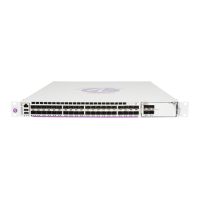IP Router Configuration
7705 SAR OS Router Configuration Guide 31
Neighbor discovery performs Layer 2 neighbor address resolution similar to ARP in IPv4. In
addition, the neighbor discovery protocol performs a neighbor reachability function, where a
“stale” neighbor entry is probed for reachability using a unicast neighbor solicitation
message. This function ensures that link-layer address changes will be discovered reliably in
addition to confirming the presence of the IPv6 neighbor.
Neighbor discovery is implemented within ICMPv6.
Router ID
The router ID is a 32-bit IP address (IPv4) that uniquely identifies the router within an
autonomous system (see Autonomous Systems).
IS-IS and BGP use the router ID as their system ID.
OSPF routers use the router IDs of the neighbor routers to establish adjacencies. Neighbor
IDs are learned when Hello packets are received from the neighbor.
Before configuring OSPF parameters, ensure that the router ID is derived by one of the
following methods:
• define the value using the config>router>router-id ip-address
command
• define the system interface using the config>router>interface
ip-int-name command (used if the router ID is not specified with the
config>router>router-id ip-address command)
A system interface (also referred to as the loopback address) must have an IP address
with a 32-bit subnet mask. The system interface is assigned during the primary router
configuration process when the interface is created in the logical IP interface context.
• if you do not specify a router ID, the last 4 bytes of the MAC address are used
• the router ID can be derived on the protocol level; for example, BGP

